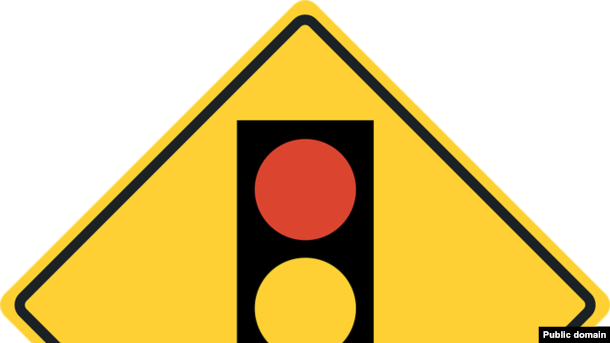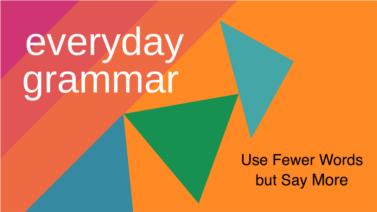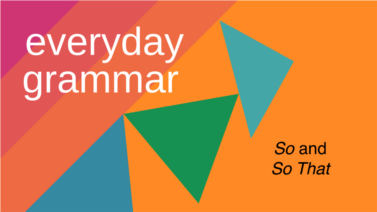
If you are driving a car, you will probably see many traffic or road signs. They provide information about how fast to go, which way to turn and whether a road ends or begins.
Languages also have signs that provide direction when speaking to others or writing. In English, we call these words “discourse markers.” Think of them as road signs for language.
We use discourse markers to signal a beginning or end of a conversation, list the order of ideas, react to a speaker, change the subject and do other things.
In other Everyday Grammar programs, we talked about such markers as “you know,” “well” and “okay.” Today, we will examine a few uses of discourse markers in informal, natural speech.
Everyday, natural speech
Some are used only used in informal speech, while others are for formal writing and speech.
You hear and see informal markers in conversations, text messages, songs, classrooms and on broadcast programs and social media.
Let us hear how they sound in a short conversation between two friends. In the following exchange, you will hear the markers “hey,” “by the way,” “let’s see” and “so.” Think about the purpose of each one:
Hey, Tasha! How is it going?
Good! I haven’t seen you in weeks. How have you been?
Busy, but great! By the way, what are you doing tomorrow night?
Let me see. I am planning on voting tomorrow afternoon but will be free after that! What did you have in mind?*
So, there is a book signing at Dream Bean coffee house tomorrow at 6 o’clock. Want to come?
That sounds great!
Did you catch the purpose of each?
The word “hey” is used to get the attention of the listener. In this case, it is also a very informal way of saying hello. English speakers use “by the way” and “so” to lead into a statement or question. But the words “by the way” inform the listener of a change in direction of the conversation. Lastly, the words “let’s see” show that the speaker is trying to remember something.

Use 1: starting a conversation
Now, let’s talk about four uses of discourse markers.
I just used one in the last sentence. Did you catch it?
It was the word “now.” We use it and other words and phrases to mark the start of a conversation or announce an idea. “Now” can introduce the idea or show a change in subject.
In Everyday Grammar programs, you have heard us use the markers “now,” “okay,” “so” and “alright.” These all tell the listener to pay attention because the speaker may offer a new piece of information.
Use 2: ending a conversation
Some of the same discourse markers are also used to end a conversation. For example, one might use the words “okay” or “alright” to inform the listener you will soon finish what you are saying. Take a listen:
Just saw your message. Alright, I’m late for a meeting. I will call you later. I have got to go!
Another word we often use is “anyway.” Here is the same example with that word:
Just saw your message. Anyway, I’m late for a meeting. I will call you later. I have got to go!
Use 3: changing the subject
Now, let’s turn to useful words and phrases for changing the subject. Notice I used “now” to move to another part of today’s subject.
You may have noticed the flexibility of some discourse markers. Some have more than one use. But be careful: Others do not.
“Anyway” is an example of a flexible marker. English speakers not only use it to suggest a conversation’s end. We also use it to signal that we will start talking about something else.
And, as you heard earlier, “by the way” is an effective phrase for quickly changing direction.
Another phrase is “That reminds me.” When someone has just said or done something that helps us remember something else, one might say, “That reminds me.”
Here is how it might be used:
Hey, do you know what the dinner special is?
Yeah, it’s teriyaki chicken.
Oh, that reminds me, I forgot to take the chicken out of my freezer!
Use 4: responding to speaker
Other discourse markers assure speakers that the listener is paying attention to what they are saying. They can show interest in, surprise at, excitement for or agreement with what the speaker is saying.
Words that show interest include “yeah” and “I see.” “Oh really” and “really” usually show surprise. And “exactly” and “right” show agreement. Here’s an example of a speaker showing agreement:
I hate riding the 43 bus! It is crowded and really stinks.
Exactly! That is why I take the train.
Okay, well, now that you have learned some road signs of the English language, we hope you will drive safely!
I’m Alice Bryant.
Alice Bryant wrote this story for Learning English. George Grow was the editor.
Reference
| Start conversation | End conversation | Introduce idea | Change subject | Respond to speaker |
|---|---|---|---|---|
| Hey, so, well | Alright, anyway, okay | Now, okay | By the way, that reminds me, | Yeah, I see, really, oh really, exactly, right |
Words in This Story
discourse - n. the use of words to exchange thoughts and ideas
conversation - n. an informal talk between two people or a small group of people
informal - adj. relaxed in tone : not suited for serious or official speech and writing
o’clock - n. according to the clock
flexible - adj. able to change or to do different things
assure - v. to make something certain
introduce - v. to present something for discussion or consideration


